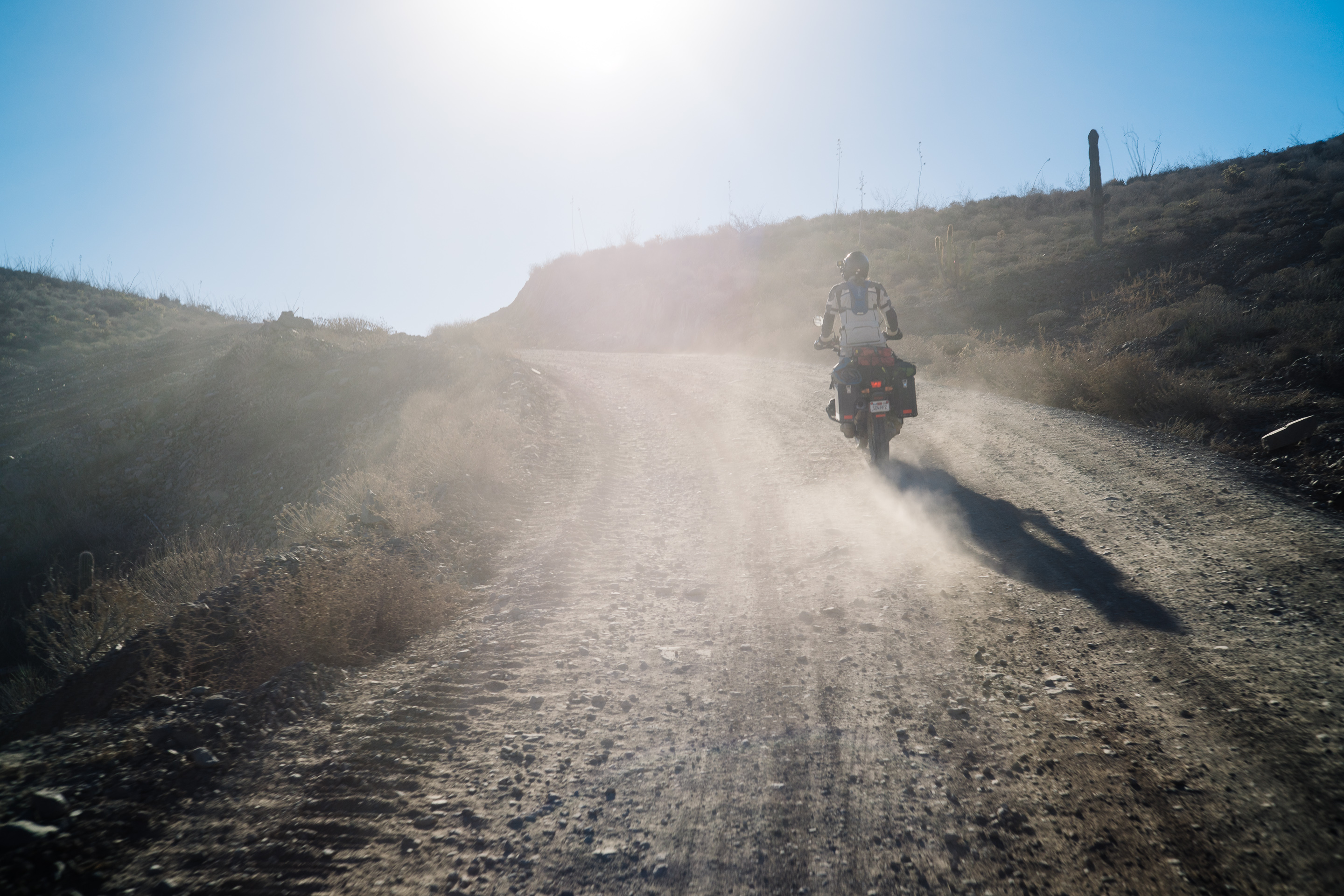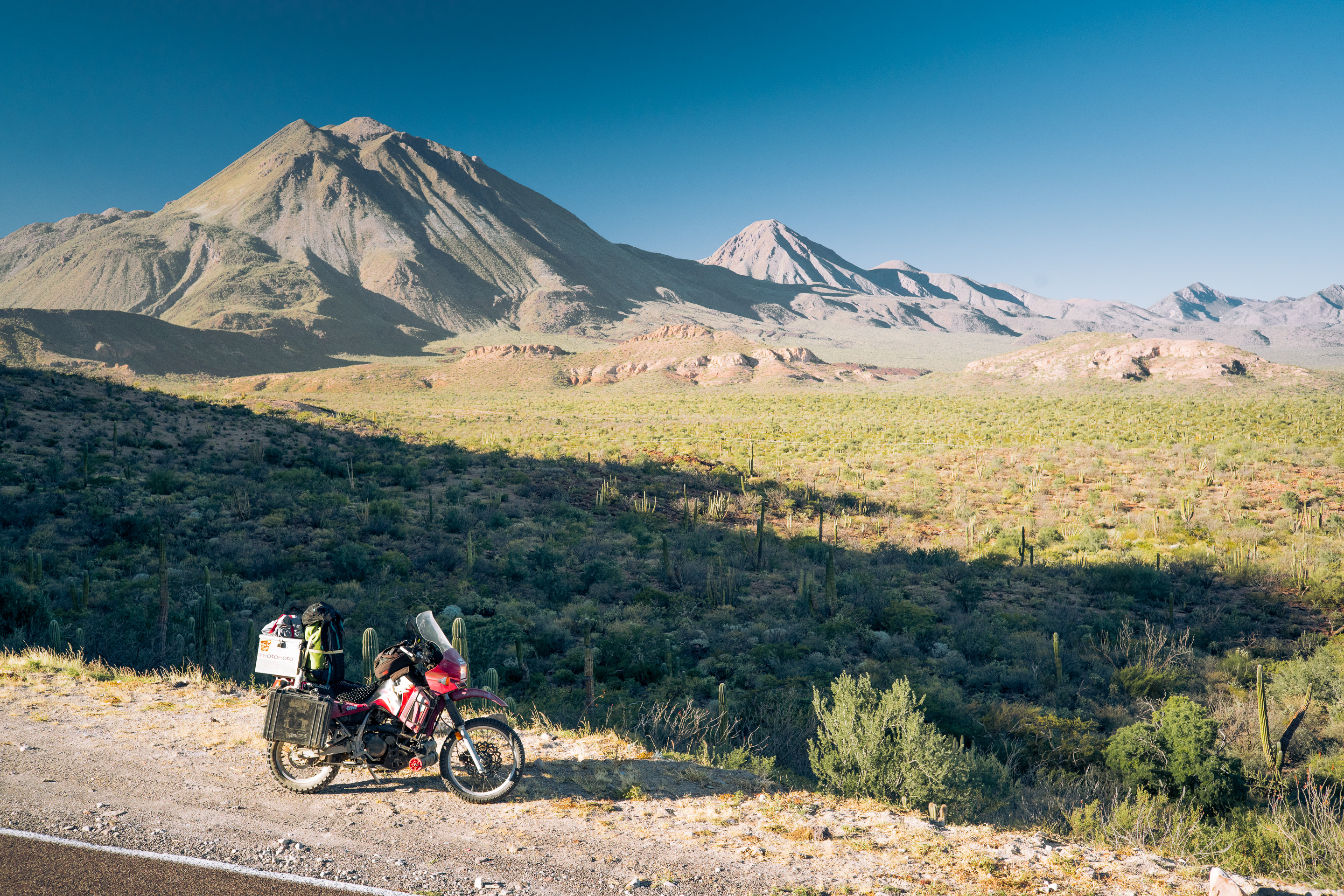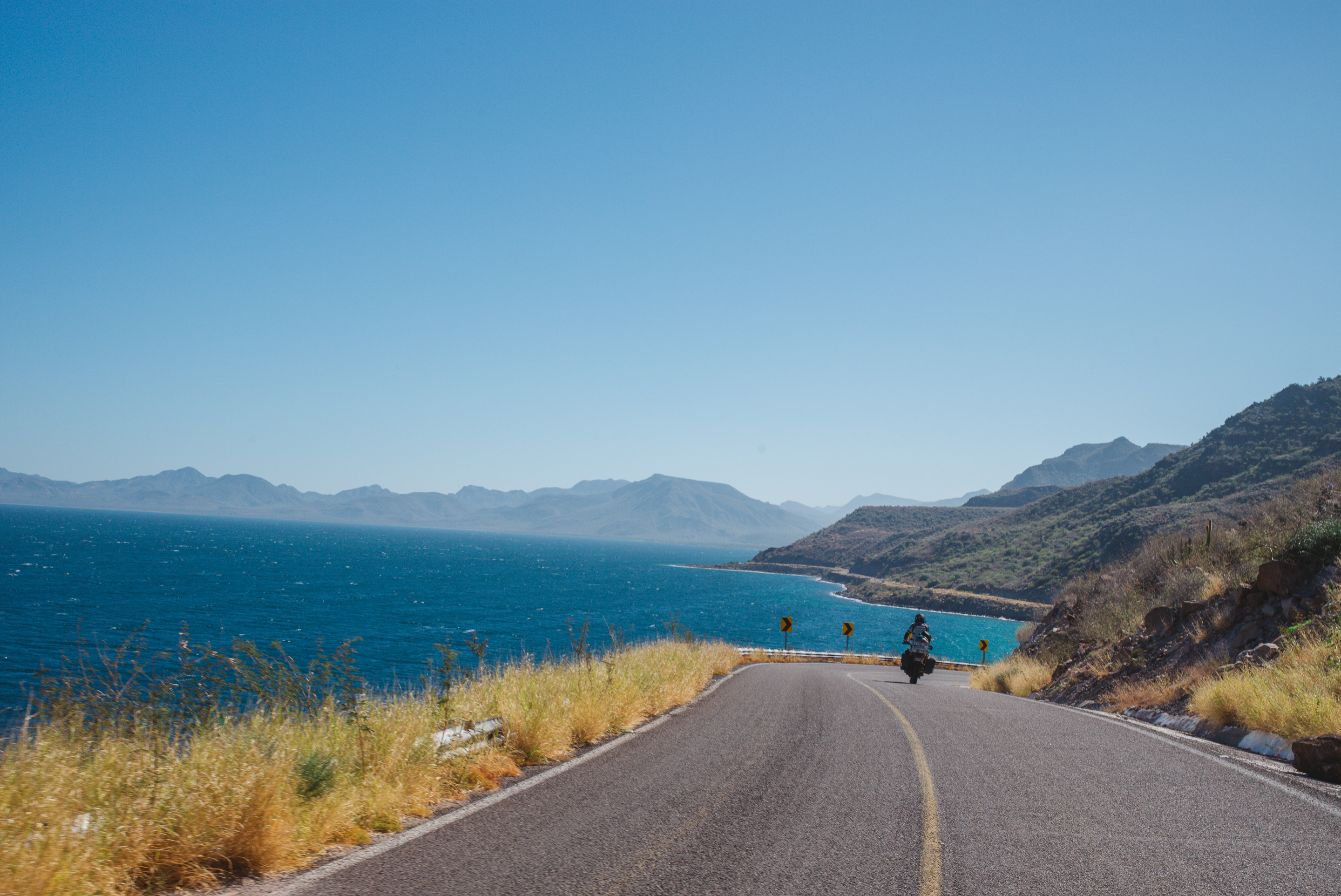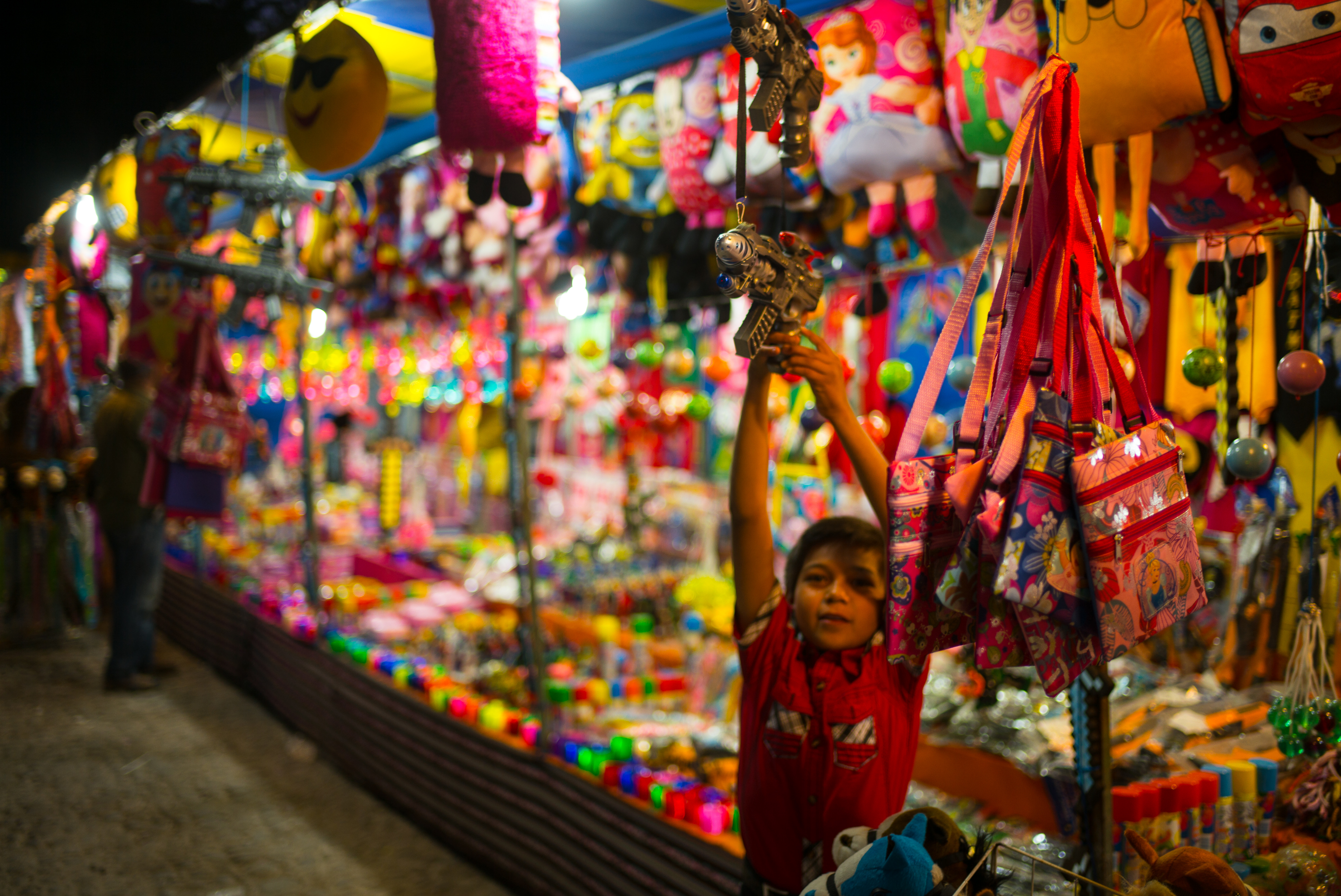After coffee with Coco, we zipped up our jackets and got on the bikes to ride… the road. The Road We Were Warned About.

The road was certainly rough. Parts were sandy and gravely, but by far the greatest annoyance and danger was large rocks and rocky sections that were very bumpy.


We made it over fine, and it wasn’t a very easy track, but it certainly wasn’t too hard either. I’d say it’s a stretch to say it was ‘the worst road’ — we’d seen far worse in Alaska in roadworks, and it’s not a jeep trail by any means.

Having crossed the ridge of mountains separating the Sea of Cortez from inland Baja, we started encountering more plant life again. Cacti, Boojum trees and shrubs popped up with increasing frequency and before we knew it we were muttering ‘whoa’ into our headsets as a cactus forest revealed itself after a turn.


We were in for a long day. We really had to make miles now, to compensate for our playing in the dirt which eats time in exchange for adrenaline and sheer joy. And miles we made: we actually left Baja del Norte, and saw a whole host of landscapes.

The road was straight for long stretches but there were some fun turns, too. On top of a particular windy hill we took some awesome shots of the landscape. I was almost blown over by the wind.


Hello, Baja California Sur!

So many beautiful landscapes, and so many cacti gave way for some sheer vast emptiness for a brief moment.

Roosting vultures only accentuated the desolate area.

Entering Baja California Sur at Guerrero Negro, the temperature went way up. Finally we got the hot desert we’d been expecting.

We also reveled in the many plentiful open and functional Pemex stations everywhere. The Mex-1 is clearly one of the main (if not the main) road through Baja, and it shows.
Our goal that day was San Ignacio, a historical mountain town but we made it even further, into Santa Rosaliá.


We stopped to take photos of the volcano that popped up on the Horizon…


And proceeded to find it.

The final drive from San Ignacio to Santa Rosaliá is insanely beautiful. It goes by the huge Volans de les Tres Virgenes and subsequent twisty, mountain roads, dipping down to the coast. Much appreciated after the straight roads inland, and gorgeous around the golden hour.

We rolled into Santa Rosaliá tired and intensely satisfied after 260+ miles on the odometer for the day, about 20 of which were rocky dirt.
Fun fact: we’d started the day essentially on the coast of the Sea of Cortez, had ridden all the way to the Pacific Coast, went over 150 miles South and then went all the way back to the coast of the Sea of Cortez. What a day.


Great hotel, too!
A quick lunch and maintenance in the morning. Chain lubing for Stuart, mostly, as the dirt roads get the chain nice and dirty — no such issue on the BMW shaft drive. I practiced my packing, which is getting better (slightly) by the day. Washboarded and rutty dirt roads rocked my fuel cans so loose they were on my seat, so I was now tying them down much more directly.

It wasn’t quite as necessary today.


The road from Santa Rosaliá to Loreto was an increidble road, easily in my favorite rides of all time. The beautiful coastal road reveals cactus forests, deciduous patches of trees and incredible views of rocky coastlines and beaches with vivid blue waters.

Perfect pavement made it highly enjoyable.

We stopped a few times to shoot photos.

This always tends to add an hour or more to our estimated travel time: stopping to take photos, riding, stopping… more photos, more riding. It’s worth it, though.


The road eventually turned inland, snaking through an interesting rough mountain landscape of low, eroded peaks covered in vegetation rising up from an epic prehistoric looking forest. Baja had turned lush.

Astonishing.


Despite being over 150 miles away, we were in Loreto before we knew it.

Loreto is a nice, friendly beach town, but we weren’t sticking around. The first few days of December, the nearby mountain town of San Javier has an immense festival where thousands of local ranchers go to celebrate the local patron saint and dance, sing and get massively drunk.

The road to San Javier was only fairly recently paved, but was incredibly beautiful.


We stopped just kilometers in for this view.

It only got better from there, with beautifully windy roads leading into a dense canyon-like landscape.

A small portion of it was still dirt, but this was quickly washed off the bikes in the many slippery water crossings. At many places in Baja we’d seen the sign for dips in the road possibly being waterlogged, but here they actually were. Some were slippery enough to make the bike slide around quite a bit, but we kept them upright and (more or less) dry.

Arriving in San Javier, we immediately stood out like a sore thumb. As the only non-Mexicans there, the locals looked at us with a combination of awe, confusion and interest. I immediately built a fan base:

These boys (and one cool girl!) were all interested in the bike, us, our clothes, our story… and were incredibly polite and patient through all of it. I only speak a bit of Spanish, but the pack leader (Guillermo, red shirt) was extremely patient with me and broke down his questions in words he knew I understood.

After we set up our tent — everybody camps at the town, which is essentially just an old Mission — he offered me a tour around the entire fiesta and I couldn’t turn it down.


Fantastic local music, arts, delicious food and lots of good times were had. I learned a lot speaking with the kids (… the mountains were so eroded due to their soft, pumice like volcanic rock!) and talking to the locals, and we got great photos.


We turned in somewhat early but the party went deep into the early hours. As I was shivering in my sleeping bag in the cold mountain night at 3 AM the music was still going strong, even after the generator was turned off.

It was time to say goodbye in the morning, and I gave the boys some stickers. They promptly surprised me by returning with a silver piece of jewelry their family had made, insisting I have it.

Incredible people. Really, it was such an experience to see how these people live. A profound sense of frontier-like mentality and living permeates their culture, and they still proudly live on the land here. Many rode up on their horses, as is tradition.
On the way out the air was chilly, and I got myself pretty wet in some of the water crossings.

Beautiful views of the valley and Loreto ahead on the way out.

Quick lunch in Loreto (beef head — Cabezas — tacos). Fantastic food.

After Loreto, we rode out through some of the few mountain curves and got on some of the perfectly straight, rather boring roads out to Cuidad Insurgentes and Cuidad Constitucion to the South Cape of Baja Sur, where we’d stop at La Paz to catch a ferry to the mainland of Mexico.

And that’s where I’ll leave this report – as I am writing this, the ferry is rocking gently on the waves and we are well on the way to Mazatlan. Baja treated us incredibly well, and we’re sad to leave with so much yet to see. La Paz (and the incredible hotel Yneka) was a great way to say goodbye.

I spent an extra day exploring La Paz, and Stuart spent his day riding around the South Cape (famously known for Cabo San Lucas and other well-visited tourist towns). Mexico has far more to show us.
We’ll update you when we get to Mexico City. For now: Adios!
